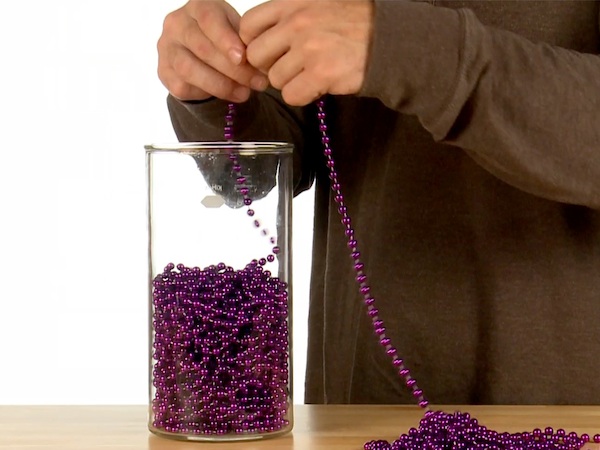Popsicle Stick Chain Reaction
Popsicle sticks are great for holding frozen treats and reading the occasional joke off of, but did you know they’re excellent for demonstrating potential and […]

A long chain of beads appears to siphon itself from a container as the beads twist and turn in a most mesmerizing dance. As you’ll see, the chain fountain doesn’t merely spill over the edge… it lifts itself out of the container, forming loops that rise higher and higher before gracefully descending to the floor. Maybe we should have called this Newton’s Dance of the Beads.

In this example, we’re using plastic “mardi gras” style beads from the craft store. However, “ball and chain” style beads from the hardware store also work well.
The key to creating the fountain of beads is to make sure the chain of beads are loaded into the container properly. It’s a good idea to wrap each end of the chain with a piece of brightly colored tape to make the ends easy to find.
Locate an end of the string of beads and lay it on the bottom of the container. Feed the beads into the container in circular layers, one after the other, one on top of the other. Don’t tangle or knot the strand as it’s loaded into the container.

It’s best to hold the container of beads as high as you can above the floor. The greater the distance between the container and the floor, the better the siphoning action will be.
Hold the container high with one hand and use the other to quickly toss the end of the string of beads up and over the edge of the container using a fast, pulling motion.

Instantly, the beads will start to climb up and over the side of the container and land on the floor (or into a second container if you’re really good). The weight of this starter section of beads will be enough to pull the rest of the beads out of the container completely.
Watch as the fountain of beads flows from the container to the floor. As the speed picks up, the string will even rise slightly above the rim of the container due to the inertia of the moving beads (more about this later). If you have the option, make a slow motion video of this so you can actually see it as it happens.

You guessed it… it’s time to load the bead back into the container and start all over again.
PRO TIP! Take it from someone who has done this a thousand times, it’s best to reload the container by finding the end of the chain of beads from the pile on the floor (it should be sitting on the top of the pile) and start loading the beads into the container. NEVER pick up the pile of beads – this will result in a tangled mess!
So, what’s the scientific secret behind this spectacle? It’s all about momentum and gravity working in concert. As gravity tugs the chain downward, it generates enough momentum to propel the chain upward and out of the jar. This creates a fascinating dynamic: the chain is simultaneously being pulled in two directions. The brief moment it takes for the chain to transition from ascending to descending is precisely what causes the loop to elevate and expand.
Let’s look at this phenomenon in terms of gravity, inertia, momentum and changing forms of energy. According to Newton, inertia is the tendency of all objects and matter in the universe to either remain motionless in the first place, or, if moving, to continue moving in the same direction and at the same speed unless acted on by some outside force that can slow them, stop them, or change their direction.
Lifting the container higher off the ground loaded potential energy into the beads. The initial tug that you gave to start the beads flowing is all that was needed to turn the potential (or gravity-stored) energy into kinetic (or motion) energy.
As the speed of the flowing beads increased, you probably noticed that the string of beads actually lifted slightly above the rim of the container due to the inertia of the fast-moving beads. The arcing of the beads is caused by the downward force of gravity overcoming the upward inertia of the moving beads. Gravity finally wins and the beads inevitably curve downward and head for the ground.
Steve Mould is a brilliant science communicator out of the UK who took the standard Newton’s Beads demonstration to a new level. During a Ted X talk, Steve was kind enough to credit is initial inspiration for his research to a Steve Spangler video he found online. His “deep dive” into the physics behind this phenomenon is so compelling that many have come to refer to Newton’s Beads as the Mould Effect.